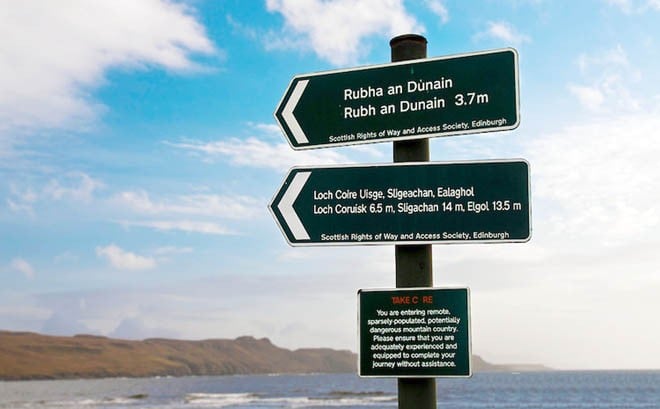
Hidden behind Edinburgh’s picturesque and dreamy scenery is the Scots’ struggle to bring the indigenous Gaelic language back to life

With its majestic spires, castles, cathedrals and a high street that stuns because of its views, Edinburgh has been rated as one of Europe’s five prettiest cities over and over again. Most visitors revel in this extraordinary beauty and the equally extraordinary warmth of its people, who take pride in welcoming thousands of tourists each year to their home city.
But behind all this, there is a different, darker history. Even now, Scotland and its parliament, set on the picturesque Holyrood Road, is locked in a battle to turn back history and reclaim some of its past. At railroad stations, along roads, at cafes, at historical places and other locations, road signs appear with the Gaelic script -- indecipherable to English readers -- displayed prominently. The fact is that only a tiny minority of 58,000 Scottish people and virtually no one from outside the region is able to communicate or read the language.
But Gaelic is important to the Scots and to the history of a land which seems determined to battle on for independence from the United Kingdom, of which it has been a part for over five centuries. The language, once spoken as the first language by Scottish people in times long forgotten, was banned in the mid-1700s after the Scots lost to the English a series of battles known as the Jacobite Rebellions. Their purpose was to restore the Catholic Stuart line to the monarchy, and while the details are complex, the war-ravaged Scotland, notably its highland areas, and left behind a legacy that is still recalled through what the Scots call the ‘weeping glens’ of their homeland. The glens of course are green; but history books tell of how the trees were stripped from them to aid English armies and weaken the position of Scottish fighters.
This grim history comes back today with the efforts to revive Gaelic, a language that some linguists insist is essentially dead -- spoken by too few to keep it alive. But there are signs that an attempted revival, backed by the Scottish National Party that rules the territory, is now on. Young Scottish children are increasingly being given traditional Gaelic names forgotten by many, such as Seonaidh (pronounced "Shaunnie"), or Eilidh (pronounced "Aylee").
The names are alien-sounding in what most visitors would regard as an English-speaking country.
That the number of young men who choose to party at night wearing traditional kilts proudly is far greater than was the case in, say, the early 1990s also points towards a similar feeling of reclaiming what has been lost.
In 1985, only 24 Scottish children were being taught in Gaelic. Most were homeschooled. Today, the number has risen to nearly 3,000 children, many of whom attend the 63 primary schools scattered through Scotland which offer Gaelic as the primary language of instruction.
Even children whose own parents speak no Gaelic are educated by teachers who speak to them only in that language. A forgotten, abandoned language which had been subjected to a deliberate attempt to murder seems to be rising up from the grave.
The first signs of this revival came in 1975, when a private landowner, holding land on the Isle of Skye in the Highlands and Islands region which runs across Scotland’s wild, desolate north, insisted that he would allow a highway to be built across his land only if the signboards were posted in Gaelic.He won his battle.
Even today, there is controversy over the Gaelic policy, endorsed by the SNP, the pro-independence Scottish party, which holds the majority in the Scottish parliament. Critics argue that posting new signboards across roads, towns, rivers and other locations is simply a waste of money that could be used for other purposes. There have also been some hilarious newspaper stories about tourists, notably in the more remote areas of the north, where signboards appear only in Gaelic, completely unable to find their way from one place to another.
No doubt, this battle will carry on. It is hard to know how it will all end. Right now, more and more websites and groups offer Gaelic language classes for adults, in many cases parents who wish to keep up with children attending Gaelic language schools.
The situation is in many ways a complex one for languages that essentially run the risk of dying -- as was the case with Gaelic, only 1.1 percent of speakers in Scotland or Ireland able to use it even until the early 2000s.
This number seems to be rising with the educational effort and others that pair up with it. The signposts are of course just a symbol of this: Israel was able to revive Hebrew and turn a language which almost no one spoke into one used by over eight million as part of its effort at national unity after Jews from around the world began moving to the Palestinian territory.
That example is in many ways an astounding one. Could Gaelic be next? Who knows; we may one day find in Scotland a people who are truly bilingual and have rediscovered a heritage taken away from them in many ways.
The ongoing battle is in many ways a hidden one. The cobbled streets, the gardens, the fairytale spires of Edinburgh, and the dreamy hills and forests that lie beyond it act as a cover. But the fight is a very real one, sweeping in with the gales that whip across the countryside in a land where a sense of turmoil marks the present just as it did the past.